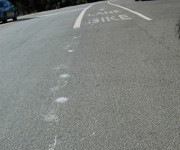Elly Blue is on a monthlong Dinner & Bikes tour around the western U.S., along with Portland bike filmmaker Joe Biel and traveling vegan chef Joshua Ploeg. This is one of her thrice-weekly dispatches from the road about bicycle culture and economy. Read them all here.
Sacramento, Calif.: Nearly every night on tour, Joe plays a short movie of some guerilla traffic engineering in action.
As our event wound down in Sacramento, someone found me out back and said, “There’s a handmade bike lane here in town, out by the zoo.”
We headed out to pursue the lead on our way out of town. “It’s on a hill,” my confidant said. On a long drive down winding, sidewalk-free road through Land Park, we had plenty of false alarms as we passed badly faded, eroded, and re-striped bike lanes. But at the end of the road was a slight uphill, and as we got closer we could see the marks of a DIY paint job.
DIY bike lane in Sacramento.Photo: Elly BlueShort, white dashes faded fast and alternated with some splatters in a different temper that suggested that the lane had been retouched at some point. Despite its telltale irregularities, the lane had a remarkably even curve and standard width.
Perfectly decent official bike lanes, unmarred by the hazard of on-street parking, grace this road for most of its length. But every few blocks, the lane on one side or the other disappears and then returns again after the next intersection. The message is loud and clear: This road is for cars.
We looked at our unofficial lane for a while before it became clear. Without warning, the bike lane on this part of the road stopped midblock and petered out into dotted lines — the way they often do in California — a half block before the beginning of a center lane that had been added for the convenience of people in cars making a left turn (a common road treatment that detractors call the “suicide lane”). Then, as we approached the next intersection, it reappeared. In this portion of the block, there were three car lanes rather than two. To keep the bike lane, the car lane on this side would have been reduced to eight feet. Though this is not unheard of, especially when trying to control the speed of traffic, whoever originally designed this road had opted to give cars the extra leeway for speed and let anyone on a bike fend for themselves.
The bike lane painter had rectified this omission. Best of all, the vigilante paint-job worked: In our time there, a couple dozen cars went by, and only one encroached on the bike lane markings. Most gave the faded stripes several feet of respectful room.
I don’t know if our white-haired informant with the jovial smile was also the amateur engineer who installed the zoo’s bike lane, but I’m hoping it was. This wouldn’t be the first time on tour someone’s told us about their clandestine efforts to improve their city’s bike infrastructure, and it’s often the people you’d least expect.
There’s something heartening about such an act of decidedly constructive rather than destructive civil disobedience. Think of it as civic participation: Anyone who grows food in a vacant lot, paints a mural on an abandoned building, or yarn bombs a public space (like the person who knitted a rainbow-striped cozy on the Sacramento Bike Kitchen’s parking rack) takes an active step forward in making the places we live, work, and ride better. They exist as examples that we aren’t all asleep at the wheel — or at least a reminder that we don’t have to be.



